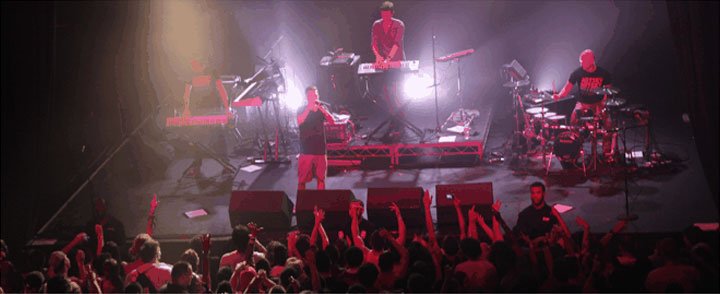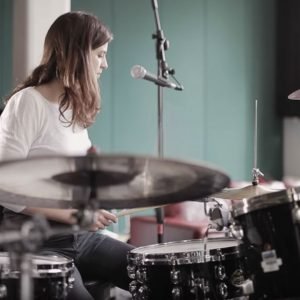A celebrity in his native Belgium and growing in popularity worldwide, Boris Daenan—better known as Netsky—has received numerous awards and accolades for his new-school brand of drum and bass.
Contributed by Roland US Team
In 2009, Hospital Records signed him to an exclusive deal, and his first release with the influential UK label was the highly successful single “Memory Lane,” followed soon after by the chart-topping debut album “Netsky.” In 2012, sensing that he could take his show to another level, the DJ and producer put his turntables aside and unveiled Netsky LIVE!, an EDM stage show featuring a complete band.
What’s the difference between the SPD-SX and the SPD-30? Find out here!
 From then on it took off—I got to know the engineers more personally, [and] they were asking me things about the music I was playing. They found it really strange that as a drummer I was also interested in using samples and triggering samples, and not just playing along with linear tracks from a CD or whatever. I’m really a little bit freaky on how it sounds and how it’s compressed and how fat you can go, and it took off from there.
I [also developed] a very good relationship and [friendship] with Steve Fisher from Roland U.S., who has been a main guy in getting the V-Drums program going, [and] also Tommy Snyder, another very important Roland demonstrator. I learned so much from them. In 2004, I had the incredible opportunity to play together with Steve when the first TD-20 set came out, and then again the success story continued.
I’m so happy that I could serve along on this wave of continuous development. The engineers in Japan, they’re just great, and they dig electronic music, acoustic music, old-school blues—they really have their thing together. I try to [advise] them [based on my experience]: “Hey, this kick sound, you need to make the people dance, this needs to be a little bit more punchy, more in the face, less effects, more compression,” and so on. Johnny Rabb is also a very important contributor. Through all these people working together, the presets in a V-Drum set are actually very representative of what it already can do, and then the user, the drummer, can go as far he wants. That’s my role in this story.
From then on it took off—I got to know the engineers more personally, [and] they were asking me things about the music I was playing. They found it really strange that as a drummer I was also interested in using samples and triggering samples, and not just playing along with linear tracks from a CD or whatever. I’m really a little bit freaky on how it sounds and how it’s compressed and how fat you can go, and it took off from there.
I [also developed] a very good relationship and [friendship] with Steve Fisher from Roland U.S., who has been a main guy in getting the V-Drums program going, [and] also Tommy Snyder, another very important Roland demonstrator. I learned so much from them. In 2004, I had the incredible opportunity to play together with Steve when the first TD-20 set came out, and then again the success story continued.
I’m so happy that I could serve along on this wave of continuous development. The engineers in Japan, they’re just great, and they dig electronic music, acoustic music, old-school blues—they really have their thing together. I try to [advise] them [based on my experience]: “Hey, this kick sound, you need to make the people dance, this needs to be a little bit more punchy, more in the face, less effects, more compression,” and so on. Johnny Rabb is also a very important contributor. Through all these people working together, the presets in a V-Drum set are actually very representative of what it already can do, and then the user, the drummer, can go as far he wants. That’s my role in this story.
Netsky LIVE uses a full arsenal of Roland gear
Netsky plays the SPD-30 and A-500 PRO, keyboardist Babl plays the JUPITER-80, VP-770, and A-800 PRO and drummer Michael Schack plays the TD-30KV V-Drums and SPD-SX Sampling Pad. Michael has a long history with Roland, both as as a product demonstrator and advisor. We caught up with him at a recent show date in Los Angeles for some insight into his gig with Netsky, including how the band uses Roland gear to deliver a more rich and dynamic live EDM experience than a one-man DJ show can. Q. How do you prepare your V-Drums set for the Netsky show? A. Actually, there’s this incredible thing that happened a few years ago: I was playing V-Drums with Kate Ryan, who is really popular in Eastern Europe. We arrived with the tour bus, and I see all kind of microphones set up close to the V-Drum pads. So, a very strange situation, because the guy didn’t actually realize that it was an electronic drum set! With electronic drums, and especially the TD-30 today—which is fast, low-latency, the best SuperNATURAL [sounds]—you can go single outs for everything. For instance, I’m using the kicks and snares in stereo, layered with the TD-30, but they’re coming out of the SPD-SX. So [they’re] triggered at the same time. And then we have the toms on separate channels, we have the hi-hat on a separate channel, the ride on a separate channel, and the two crashes on a separate stereo channel. [With] so many separate channels, [the sound engineer] can actually make it sound very wide. You can adjust the panning to every concert hall. You can totally go wild in making the sound as broad as possible, which is much more impressive than a USB stick just playing a stereo out through a DJ mixer. Same for the keyboards—it’s hardware and software combined. So all the synth sounds, all the pianos [have] separate stereo channels, so that’s really a very important main difference with any DJ set, which actually sounds a little bit more compressed, and not so wide-spectrum, not so dynamic. Q: With all that Roland gear on stage, how long does the sound check usually take? From then on it took off—I got to know the engineers more personally, [and] they were asking me things about the music I was playing. They found it really strange that as a drummer I was also interested in using samples and triggering samples, and not just playing along with linear tracks from a CD or whatever. I’m really a little bit freaky on how it sounds and how it’s compressed and how fat you can go, and it took off from there.
I [also developed] a very good relationship and [friendship] with Steve Fisher from Roland U.S., who has been a main guy in getting the V-Drums program going, [and] also Tommy Snyder, another very important Roland demonstrator. I learned so much from them. In 2004, I had the incredible opportunity to play together with Steve when the first TD-20 set came out, and then again the success story continued.
I’m so happy that I could serve along on this wave of continuous development. The engineers in Japan, they’re just great, and they dig electronic music, acoustic music, old-school blues—they really have their thing together. I try to [advise] them [based on my experience]: “Hey, this kick sound, you need to make the people dance, this needs to be a little bit more punchy, more in the face, less effects, more compression,” and so on. Johnny Rabb is also a very important contributor. Through all these people working together, the presets in a V-Drum set are actually very representative of what it already can do, and then the user, the drummer, can go as far he wants. That’s my role in this story.
From then on it took off—I got to know the engineers more personally, [and] they were asking me things about the music I was playing. They found it really strange that as a drummer I was also interested in using samples and triggering samples, and not just playing along with linear tracks from a CD or whatever. I’m really a little bit freaky on how it sounds and how it’s compressed and how fat you can go, and it took off from there.
I [also developed] a very good relationship and [friendship] with Steve Fisher from Roland U.S., who has been a main guy in getting the V-Drums program going, [and] also Tommy Snyder, another very important Roland demonstrator. I learned so much from them. In 2004, I had the incredible opportunity to play together with Steve when the first TD-20 set came out, and then again the success story continued.
I’m so happy that I could serve along on this wave of continuous development. The engineers in Japan, they’re just great, and they dig electronic music, acoustic music, old-school blues—they really have their thing together. I try to [advise] them [based on my experience]: “Hey, this kick sound, you need to make the people dance, this needs to be a little bit more punchy, more in the face, less effects, more compression,” and so on. Johnny Rabb is also a very important contributor. Through all these people working together, the presets in a V-Drum set are actually very representative of what it already can do, and then the user, the drummer, can go as far he wants. That’s my role in this story.








